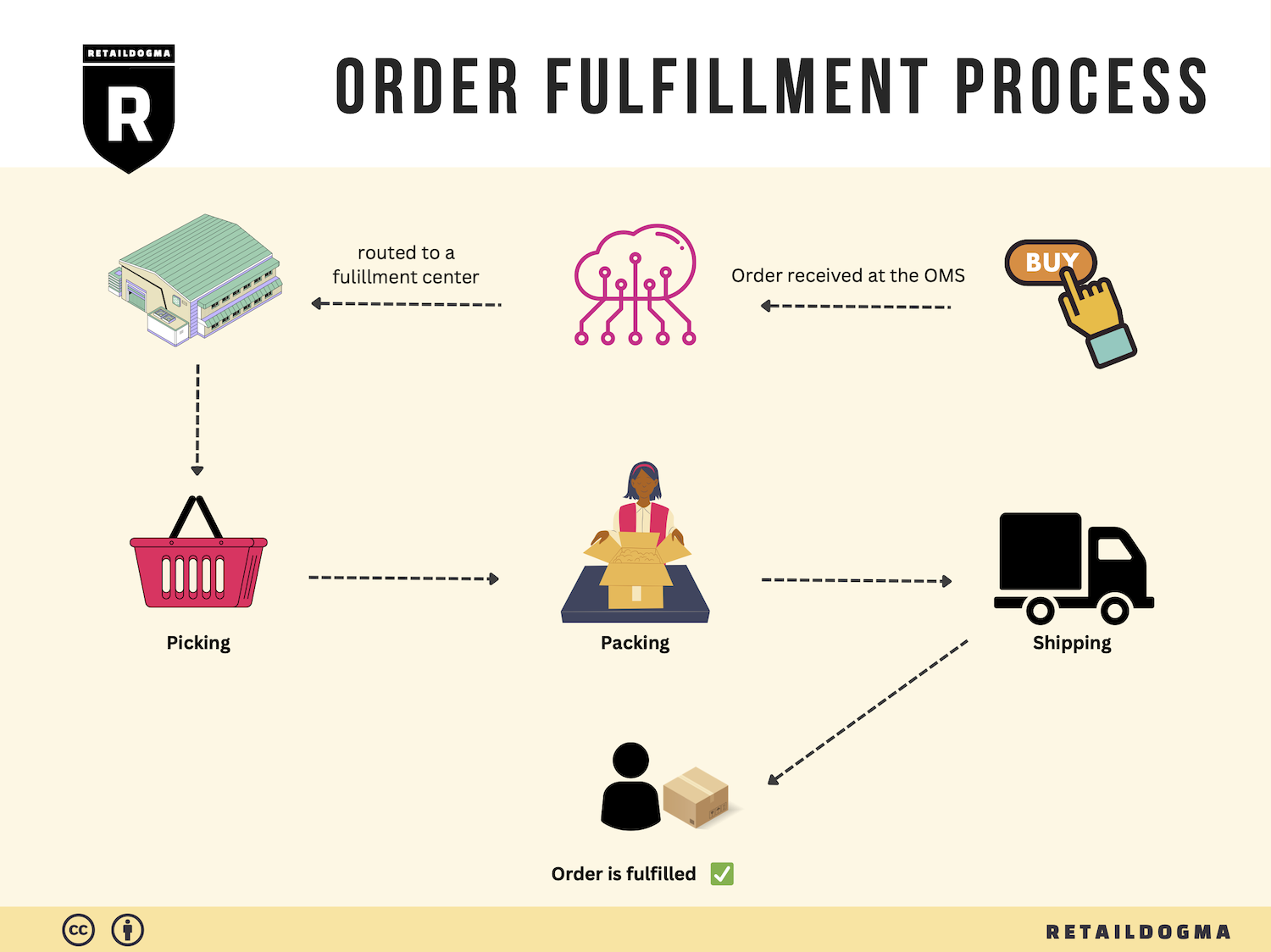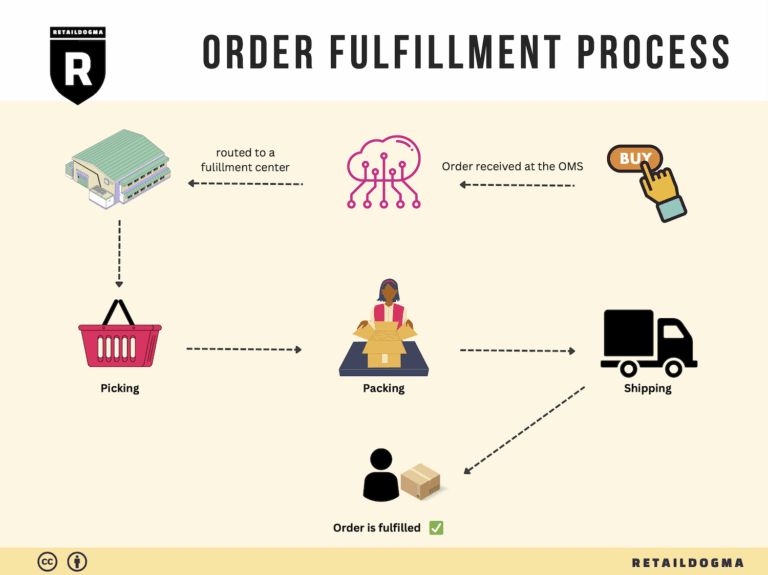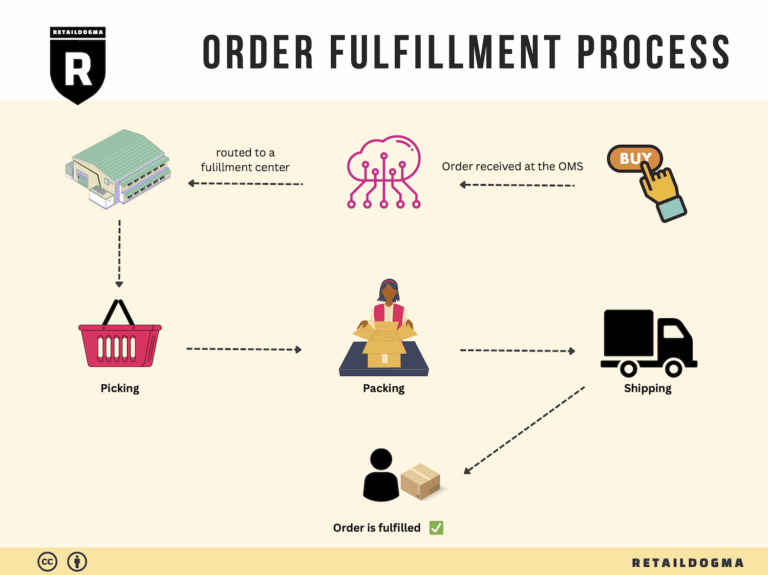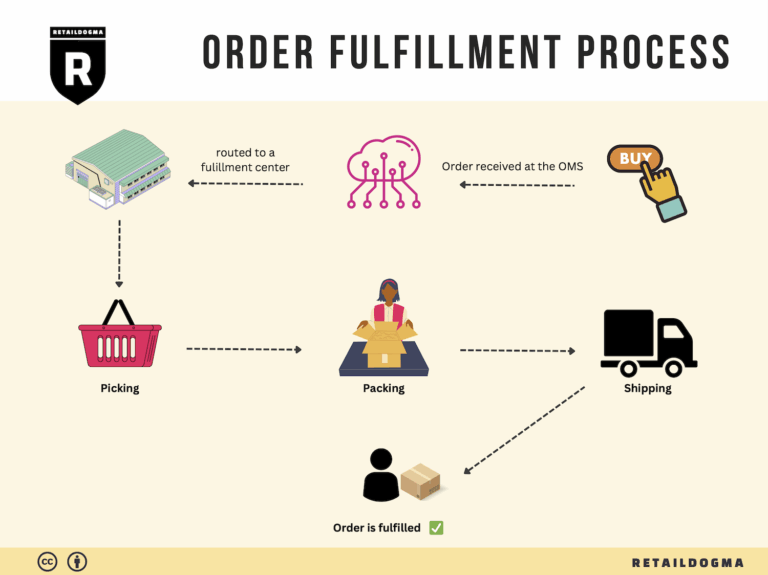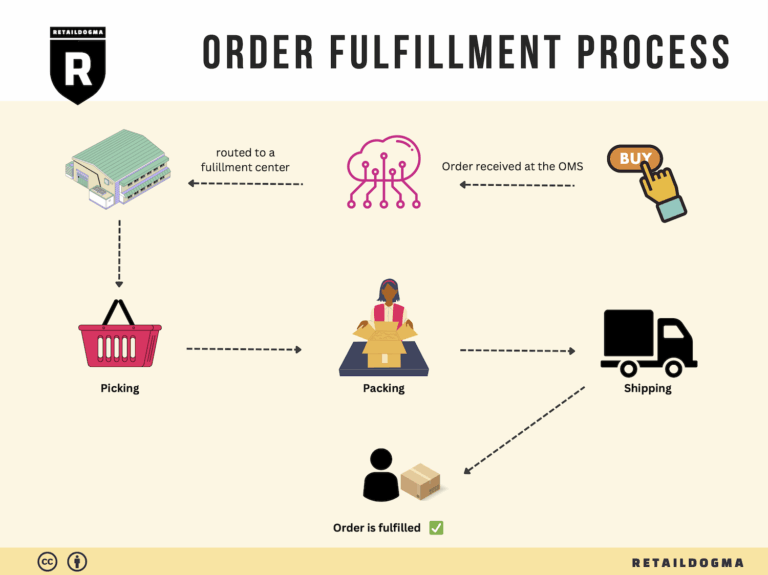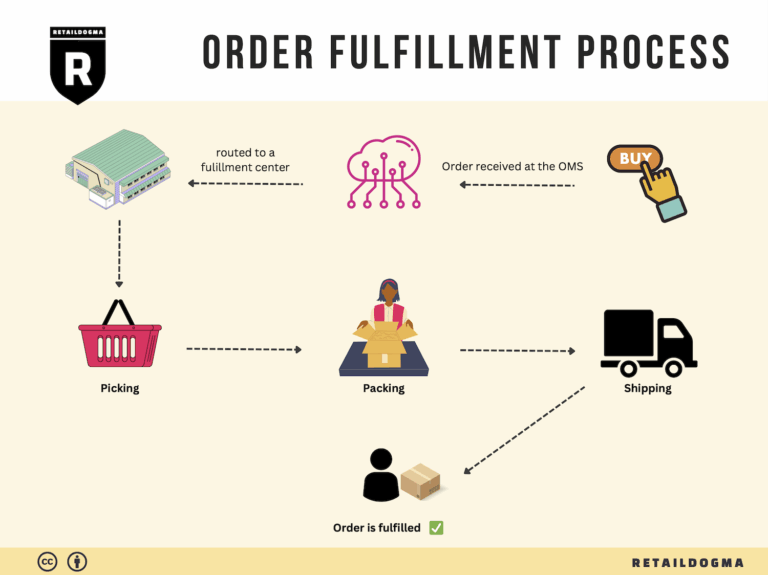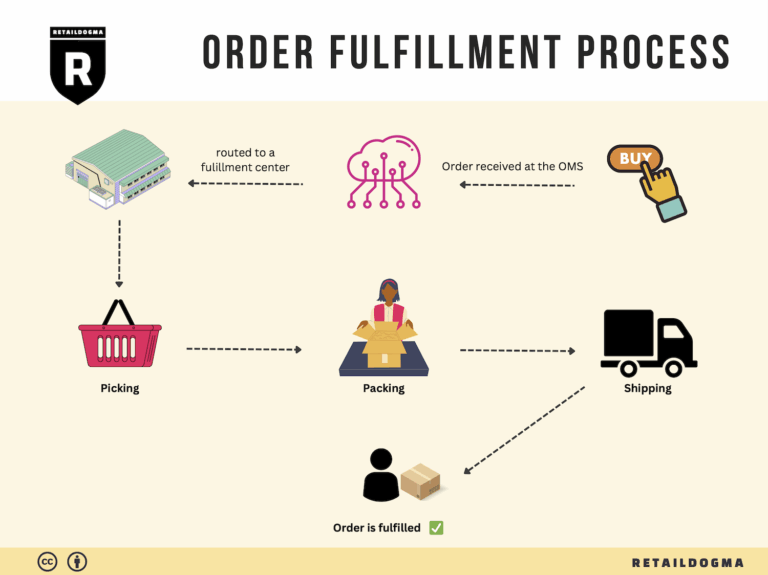Ecommerce Fulfillment Services: The Ultimate Guide (2025)
What is E-commerce Fulfillment? An Introduction for Growing Businesses
The Challenge of Packing and Shipping Orders
As your e-commerce business begins to grow, you might find yourself overwhelmed by the demands of packing and shipping orders. What once seemed manageable can quickly turn into a logistical nightmare, taking valuable time and resources away from other critical aspects of your business. The process of fulfillment—the series of steps involved in getting a product from your inventory to your customer’s doorstep—can become a significant pain point that hinders your growth.
Understanding E-commerce Fulfillment
E-commerce fulfillment is the backbone of your online retail operation. It encompasses everything from receiving inventory and storing products to packing orders and shipping them to customers. For growing businesses, efficient fulfillment is crucial for maintaining customer satisfaction and loyalty, especially in an era where fast shipping is expected.
This guide aims to demystify the various facets of e-commerce fulfillment, providing you with the knowledge to make informed decisions as your business scales. We will explore different fulfillment models, such as Third-Party Logistics (3PL) and Fulfillment by Amazon (FBA), outlining their advantages and disadvantages. Understanding these models will help you determine which option aligns best with your business goals and operational needs.
Core Services and Key Considerations
In addition to exploring fulfillment models, we will delve into the core services typically offered by fulfillment partners. These include inventory management, order processing, packing, shipping, and returns handling. Each service plays a vital role in ensuring a seamless customer experience, and recognizing the importance of these components will empower you to choose the right partner.
Choosing a fulfillment partner is a critical decision that can impact your bottom line. We will provide practical tips on evaluating potential partners based on factors such as location, technology, scalability, and pricing. Understanding these elements will enable you to forge partnerships that enhance your operational efficiency and customer satisfaction.
Making Smart Decisions for Your Logistics
Finally, we will address the often-complex topic of pricing in e-commerce fulfillment. By breaking down the costs associated with different models and services, we aim to equip you with the insights necessary to budget effectively and avoid hidden fees.
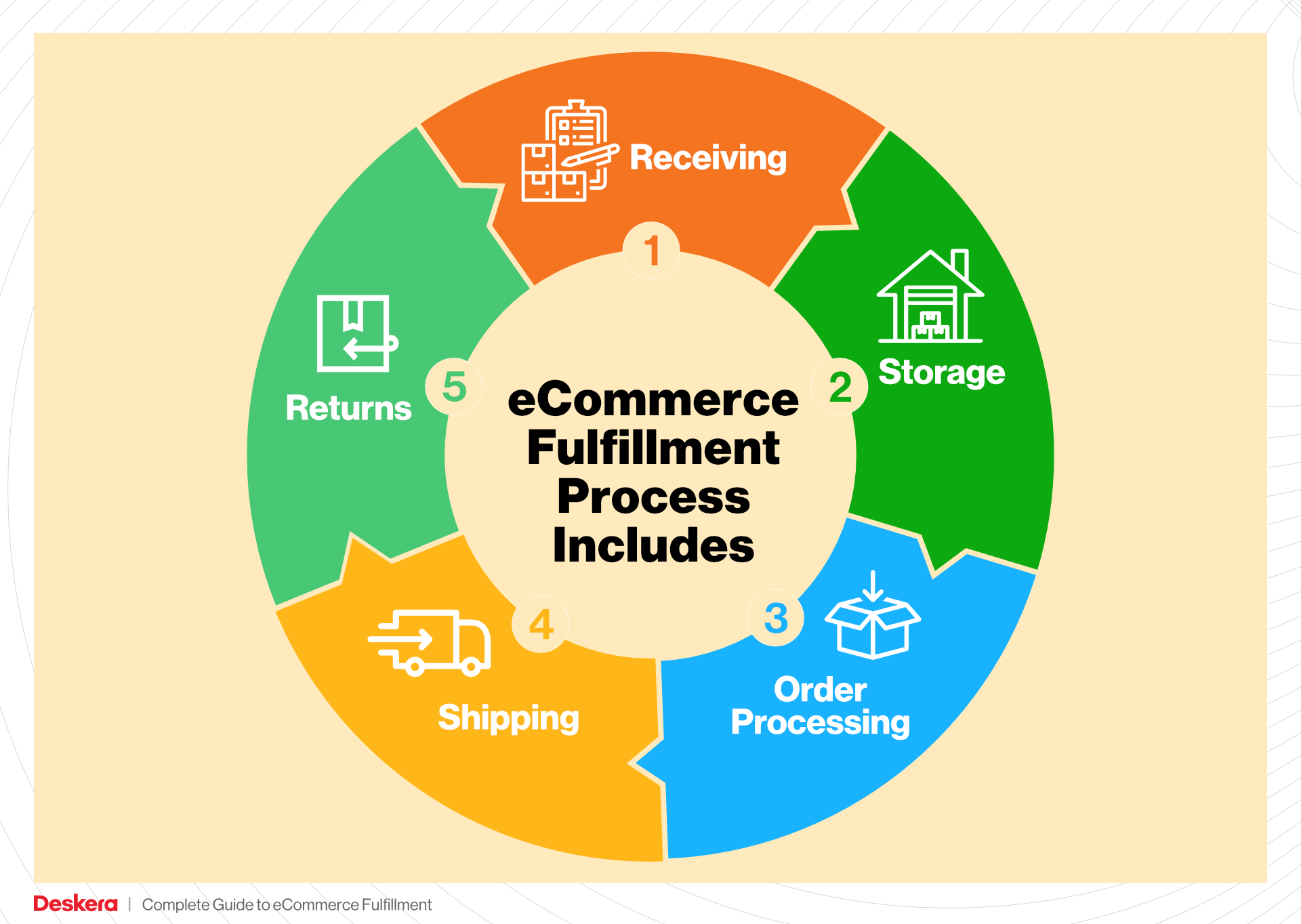
This guide is designed to empower you to make smart, informed decisions about your logistics strategy. By understanding the ins and outs of e-commerce fulfillment, you can streamline operations, enhance customer satisfaction, and position your business for sustained growth.
What You’ll Learn In This Guide
- What is E-commerce Fulfillment? An Introduction for Growing Businesses
- The Order Fulfillment Process: From ‘Buy’ Button to Customer’s Door
- Comparing Fulfillment Models: In-House vs. 3PL vs. Dropshipping
- A Deep Dive into Amazon FBA: Pros, Cons, and Who It’s For
- Core Services Offered by Fulfillment Centers
- How to Choose a Fulfillment Partner: A 6-Point Checklist
- Understanding Fulfillment Pricing: A Breakdown of Common Fees
- Frequently Asked Questions (FAQs) about Fulfillment
- Conclusion: Is Outsourcing Fulfillment the Right Move for Your Business?
- Important Disclaimer
The Order Fulfillment Process: From ‘Buy’ Button to Customer’s Door
1. Receiving Inventory
The first step in the order fulfillment process is receiving inventory at the fulfillment center. When products arrive, they are checked against purchase orders to ensure accuracy in quantity and quality. This process involves scanning each item using a system that assigns a Stock Keeping Unit (SKU) to each product. The SKU is crucial as it helps in tracking inventory levels and locations within the warehouse.
Receiving inventory efficiently is vital for maintaining a seamless supply chain. Accurate receiving reduces discrepancies, minimizes returns, and ensures that the right products are available when customers place their orders. Additionally, an organized receiving process lays the foundation for effective inventory management, which is essential for scaling operations.
2. Warehouse Storage
Once inventory is received, the next step is to store the products in designated areas of the warehouse. The storage process involves categorizing and shelving items based on various factors such as size, type, and sales velocity. This organization can include using bin locations, pallet racks, or automated storage systems, which facilitate easy access and retrieval.
Proper warehouse storage is critical for maximizing space utilization and ensuring quick order fulfillment. By employing techniques like zone storage or FIFO (First In, First Out), businesses can enhance their operational efficiency. A well-structured storage system minimizes the time spent locating products, which directly impacts the speed of order processing and customer satisfaction.
3. Order Picking
Order picking is the process of retrieving items from their storage locations to fulfill customer orders. This step can be performed using different methods, such as single order picking, batch picking, or wave picking. Each method has its advantages depending on the volume and type of orders being processed.
The importance of order picking cannot be overstated; it directly affects the accuracy of shipments and the overall customer experience. Utilizing tools like pick lists, which detail the items and quantities needed for each order, helps streamline this process. Efficient picking methods reduce the likelihood of errors, enhance productivity, and ultimately lead to faster delivery times, which is crucial for maintaining competitive advantage in the e-commerce landscape.
4. Order Packing
After items have been picked, they move to the packing stage. Here, products are prepared for shipment by being carefully packaged to prevent damage during transit. This process often includes selecting appropriate packaging materials, adding protective fillers, and labeling each package accurately.
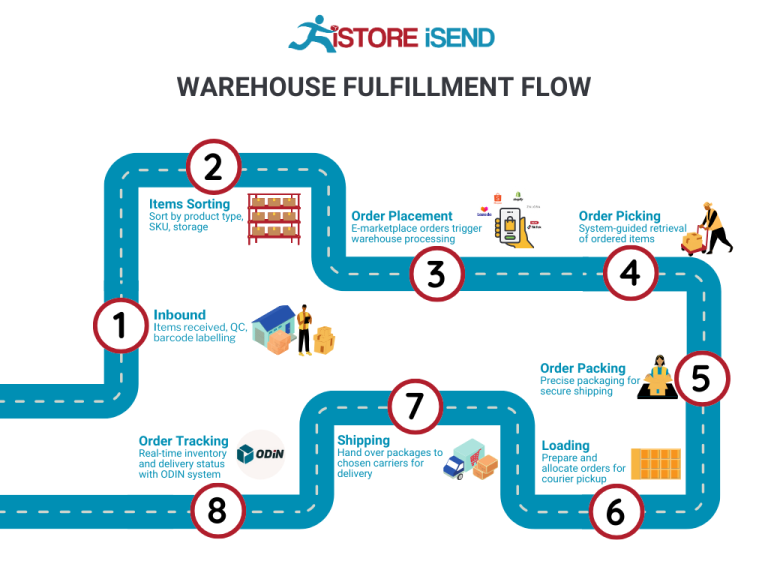
Packing is a significant step in the fulfillment process because it ensures that products arrive at customers’ doors in perfect condition. Effective packing reduces the risk of returns and enhances customer satisfaction. Additionally, incorporating branding elements into packaging can improve the overall customer experience and foster brand loyalty. Key terms associated with packing include packing slips and shipping labels, which are essential for tracking and confirming deliveries.
5. Shipping & Delivery
The final step in the order fulfillment process is shipping and delivery. Once packages are packed, they are handed over to shipping carriers such as UPS, FedEx, or USPS. The choice of carrier and shipping method can depend on factors such as cost, speed, and destination. Fulfillment centers like Amazon SCK3 leverage their strategic location and relationships with various carriers to optimize shipping efficiency.
Shipping and delivery are crucial as they are the last touchpoint between the business and the customer. Timely delivery directly influences customer satisfaction and retention rates. To enhance this process, businesses should consider implementing tracking systems that allow customers to monitor their orders in real-time. This transparency builds trust and encourages repeat purchases, which is essential for scaling e-commerce operations.
In conclusion, understanding and optimizing each step of the order fulfillment process—from receiving inventory to shipping and delivery—is key for e-commerce businesses aiming to scale effectively. By focusing on efficiency, accuracy, and customer satisfaction, businesses can create a robust fulfillment strategy that supports growth and enhances their competitive edge in the market.
Comparing Fulfillment Models: In-House vs. 3PL vs. Dropshipping
Fulfillment Model Comparison
| Model | Who Handles Inventory | Best For (Business Stage) | Key Advantage | Key Disadvantage |
|---|---|---|---|---|
| In-House Fulfillment | Business (Owner/Staff) | Established Businesses | Full control over inventory and fulfillment | High overhead costs and resource needs |
| Third-Party Logistics (3PL) | Third-Party Providers | Growing Businesses | Scalability and expertise in logistics | Less control over inventory and processes |
| Dropshipping | Supplier | Startups and Small Businesses | Low upfront investment and risk | Lower profit margins and longer shipping times |
In-House Fulfillment
In-house fulfillment involves managing all aspects of the inventory and shipping process within the business itself. This model is ideal for established businesses that have the resources and infrastructure to handle their logistics. Companies opting for in-house fulfillment maintain full control over their inventory, allowing them to manage stock levels, quality control, and order processing directly. This can lead to a more personalized customer experience, as businesses can tailor their fulfillment processes to align with their brand values and customer expectations. However, this model comes with significant overhead costs, including warehousing, staffing, and technology investments. Moreover, as order volumes increase, businesses may find it challenging to scale operations efficiently without incurring additional costs.
Third-Party Logistics (3PL)
Third-party logistics (3PL) providers offer a solution for businesses looking to outsource their fulfillment processes. In this model, a third-party company handles the storage, packing, and shipping of products on behalf of the business. This model is particularly beneficial for growing businesses that require scalability and expertise in logistics without the burden of managing these processes in-house. 3PL providers often have established networks, advanced technology, and industry knowledge, enabling businesses to streamline their operations and focus on core activities such as marketing and product development. However, utilizing a 3PL can result in reduced control over inventory management and fulfillment processes. Businesses may face challenges with communication and coordination, particularly if they are not aligned with their 3PL provider’s systems and processes.
Dropshipping
Dropshipping is a fulfillment model where the retailer does not keep products in stock. Instead, when a customer places an order, the retailer purchases the item from a third-party supplier who then ships it directly to the customer. This model is particularly attractive for startups and small businesses due to its low upfront investment and minimal risk. Retailers can offer a wide range of products without the need for significant inventory investments or warehouse space, allowing them to focus on marketing and customer engagement. However, dropshipping typically comes with lower profit margins, as suppliers take a cut of the sales. Additionally, retailers often face longer shipping times and potential quality control issues, as they rely on third-party suppliers to fulfill orders accurately and timely. This can lead to customer dissatisfaction if not managed carefully.
Conclusion
Choosing the right fulfillment model is crucial for the success of an e-commerce business. Each model—In-House Fulfillment, Third-Party Logistics, and Dropshipping—offers unique advantages and disadvantages tailored to different business stages and operational capacities. Businesses must assess their current needs, growth trajectory, and resource availability to select the most suitable fulfillment strategy. Balancing control, cost, and efficiency will ultimately define the effectiveness of their logistics and supply chain operations, enabling them to scale successfully in the competitive e-commerce landscape.
A Deep Dive into Amazon FBA: Pros, Cons, and Who It’s For
What is Fulfillment by Amazon (FBA)?
Fulfillment by Amazon (FBA) is a service provided by Amazon that allows sellers to store their products in Amazon’s extensive network of fulfillment centers. Amazon then takes care of storage, packaging, and shipping of products to customers. This system enables sellers to leverage Amazon’s infrastructure, including its customer service and advanced logistics, to reach a vast customer base.
When a seller opts for FBA, their products become eligible for Amazon Prime, which offers customers expedited shipping options. The process is relatively straightforward: sellers send their inventory to Amazon’s fulfillment centers, and when a customer places an order, Amazon handles the picking, packing, and shipping of the product. Additionally, Amazon manages returns and customer inquiries, which can be a significant relief for e-commerce business owners who want to focus on growth rather than day-to-day operations.
How FBA Works
-
Inventory Storage: Sellers send their products to one or more of Amazon’s fulfillment centers. Amazon SCK3 in Manteca, CA, for example, is one of these centers, strategically located for efficient logistics and timely delivery.
-
Order Fulfillment: When a customer places an order for an FBA product, Amazon picks the item from its inventory, packs it, and ships it directly to the customer.
-
Customer Service: Amazon handles all customer service inquiries related to FBA orders, including returns and refunds. This allows sellers to benefit from Amazon’s customer service reputation.
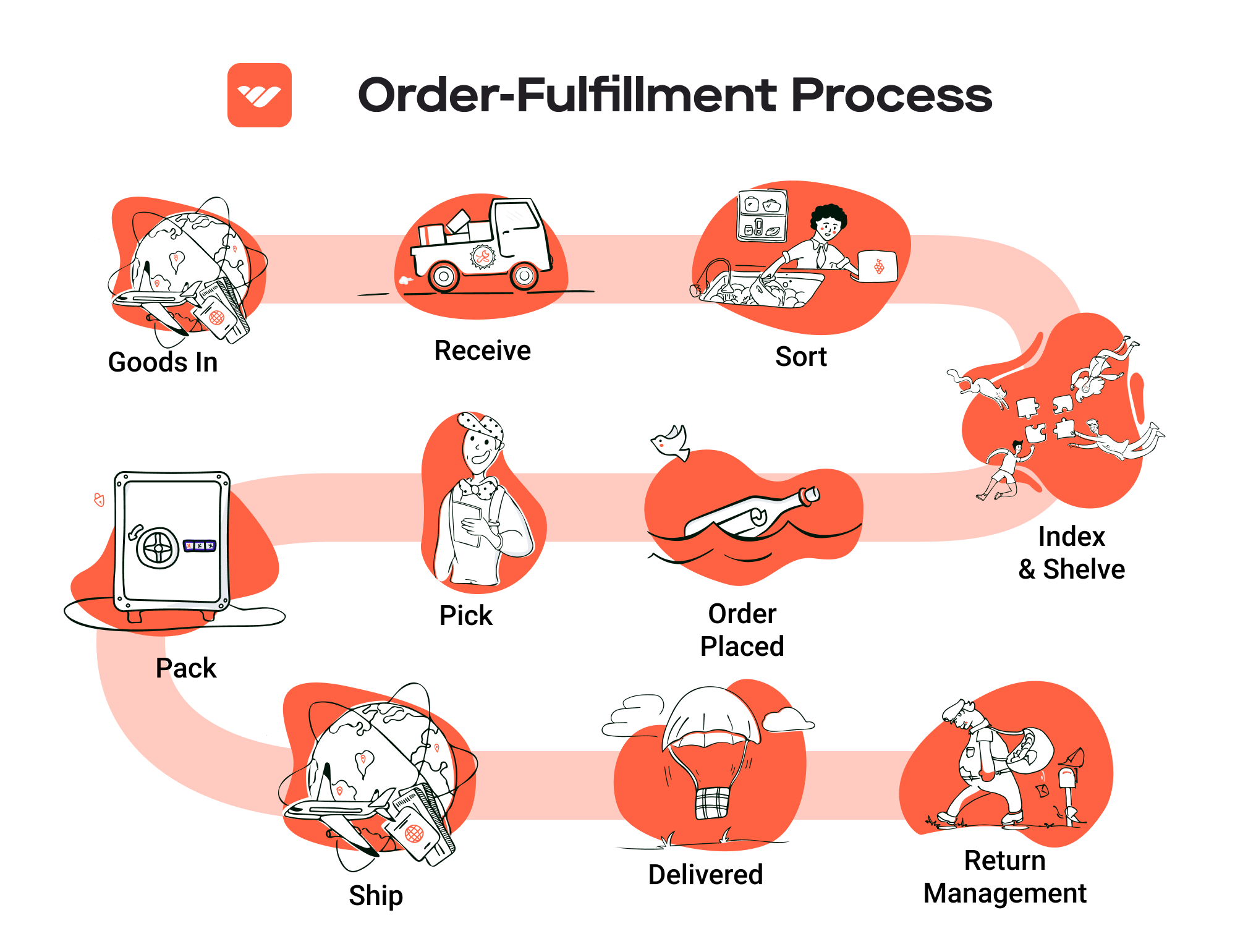
-
Multi-Channel Fulfillment: Sellers can also use FBA to fulfill orders from other sales channels, such as their own e-commerce websites, eBay, or other platforms, allowing for streamlined logistics across multiple marketplaces.
Pros of Fulfillment by Amazon (FBA)
1. Prime Eligibility
One of the most significant advantages of using FBA is the eligibility for Amazon Prime. Prime members enjoy free two-day shipping on millions of products, which can significantly enhance a seller’s visibility and sales. Products fulfilled by Amazon are prominently featured in search results, increasing the likelihood of sales.
2. Customer Trust
Amazon has built a strong reputation for reliability and customer service. By using FBA, sellers can leverage this trust. Customers are more likely to purchase products that are fulfilled by Amazon due to the perceived assurance of quality service, fast shipping, and easy returns.
3. Multi-Channel Fulfillment
FBA allows sellers to fulfill orders not just on Amazon but across multiple channels. This flexibility means that sellers can centralize their inventory management and logistics, reducing complexity and potentially lowering costs associated with shipping and handling.
4. Scalability
FBA provides a scalable solution for growing businesses. As sales increase, sellers can quickly send more inventory to Amazon without needing to invest in their own warehousing and logistics infrastructure. This scalability is particularly beneficial for seasonal businesses that experience fluctuating demand.
5. Time Savings
By outsourcing fulfillment to Amazon, sellers can save significant time that would otherwise be spent on packing, shipping, and handling customer service inquiries. This allows them to focus on other critical aspects of their business, such as marketing and product development.
Cons of Fulfillment by Amazon (FBA)
1. High Fees
FBA is not without its costs. Amazon charges various fees, including storage fees for storing inventory in their warehouses and fulfillment fees for picking, packing, and shipping products. For some sellers, especially those with low margins, these fees can eat into profits significantly.
2. Strict Inventory Rules
Sellers must adhere to Amazon’s stringent inventory management policies, including how products are packaged and labeled. Non-compliance can result in additional fees or even the removal of inventory. Managing these rules can be time-consuming and requires careful attention to detail.
3. Commingling Risks
Amazon uses a system known as commingling, where products from different sellers are stored together. While this can streamline the fulfillment process, it also poses risks. If a seller’s inventory is mixed with defective or subpar products from other sellers, it can lead to negative reviews and customer dissatisfaction.
4. Lack of Control
When using FBA, sellers relinquish a degree of control over their fulfillment process. This can lead to challenges, particularly if there are issues with inventory management or order accuracy, which can affect customer satisfaction and, ultimately, sales.
5. Dependency on Amazon
Relying heavily on FBA can create a dependency on Amazon’s platform. Changes in Amazon’s policies, fees, or algorithms can significantly impact a seller’s business, making it crucial to have contingency plans in place.
Who is FBA Best For?
Fulfillment by Amazon is best suited for sellers who:
- Have a Diverse Product Range: Businesses with a wide variety of products can benefit from FBA’s extensive network and logistics capabilities.
- Aim for Rapid Growth: Sellers looking to scale quickly and leverage Amazon’s vast customer base will find FBA to be a valuable tool.
- Sell High-Volume Items: Products with higher sales velocity can absorb FBA fees more effectively, making it a financially viable option.
- Want to Focus on Core Business Functions: Entrepreneurs who prefer to concentrate on marketing, product development, and customer engagement rather than logistics will find FBA advantageous.
- Are Comfortable with Amazon’s Ecosystem: Sellers who are already established on Amazon and understand its marketplace dynamics will likely see the most benefit from integrating FBA into their operations.
In conclusion, while FBA offers a powerful set of advantages for scaling e-commerce businesses, it is essential for sellers to carefully weigh the pros and cons and consider their specific business needs before fully committing to the program.
Core Services Offered by Fulfillment Centers
Inventory Management & Warehousing
Inventory management and warehousing are foundational services provided by fulfillment centers that significantly enhance the operational efficiency of e-commerce businesses. This service encompasses the storage, tracking, and management of products in a dedicated facility. Fulfillment centers use advanced inventory management systems that offer real-time visibility into stock levels, allowing businesses to monitor their inventory without the need for manual oversight.
Benefits:
-
Optimized Space Utilization: Fulfillment centers are designed to maximize storage efficiency. They utilize various techniques, such as pallet racking and shelving, to ensure that space is used effectively, reducing overhead costs for e-commerce businesses.
-
Reduced Risk of Stockouts: With accurate inventory tracking, businesses can maintain optimal stock levels, minimizing the risk of stockouts that can lead to lost sales and dissatisfied customers.
-
Scalability: As an e-commerce business grows, fulfillment centers can easily scale storage capacity. This flexibility allows businesses to adapt quickly to changing demand without investing in additional warehousing infrastructure.
-
Cost Efficiency: By outsourcing inventory management to a fulfillment center, e-commerce businesses can lower their operational costs. They avoid the expenses associated with maintaining their own warehouse, including rent, utilities, and staffing.
Pick and Pack Services
Pick and pack services are a critical component of the fulfillment process, involving the selection (picking) of products from inventory and the preparation (packing) of those items for shipment. This process is typically automated and optimized for speed and accuracy, ensuring that orders are fulfilled correctly and delivered on time.
Benefits:
-
Increased Order Accuracy: Automated systems and trained staff ensure that the correct items are picked for each order, significantly reducing errors. This accuracy enhances customer satisfaction and loyalty.
-
Faster Turnaround Times: Fulfillment centers utilize efficient picking methods, such as batch picking and zone picking, to expedite the order fulfillment process. Faster turnaround times lead to improved customer experiences and can increase repeat business.
-
Custom Packaging Options: Many fulfillment centers offer custom packing solutions, allowing businesses to enhance their brand presentation. This could include branded packaging materials or personalized inserts, which can improve customer engagement.
-
Integration with E-commerce Platforms: Fulfillment centers often provide seamless integration with various e-commerce platforms, enabling real-time updates on inventory levels and order statuses. This integration streamlines the order management process and enhances operational efficiency.
Kitting and Assembly
Kitting and assembly services involve the grouping of various products into ready-to-sell packages or kits. This service is particularly beneficial for businesses that offer bundled products or require assembly before shipping. Fulfillment centers can handle this process efficiently, ensuring that all components are included and packaged appropriately.
Benefits:
-
Enhanced Product Offerings: Kitting allows businesses to create unique product bundles that can attract customers and increase average order value. This can be particularly useful for promotions or seasonal offerings.
-
Time Savings: By outsourcing kitting and assembly, e-commerce businesses can save valuable time and resources. Fulfillment centers have the expertise and equipment necessary to perform these tasks efficiently, allowing businesses to focus on core activities such as marketing and sales.
-
Quality Control: Fulfillment centers implement quality control measures during the kitting process to ensure that all products meet specified standards. This reduces the likelihood of returns and enhances customer satisfaction.
-
Flexibility: As market demands change, kitting services provide the flexibility to quickly adjust product offerings. Businesses can rapidly introduce new bundles or modify existing ones without significant operational disruptions.
Returns Management (Reverse Logistics)
Returns management, also known as reverse logistics, is a vital service provided by fulfillment centers that addresses the processing of returned items. Efficient returns management is crucial for e-commerce businesses, as it directly impacts customer satisfaction and operational efficiency.
Benefits:
-
Streamlined Returns Processing: Fulfillment centers have established processes for handling returns, including inspection, restocking, and disposition of returned items. This efficiency minimizes downtime and helps businesses recover value from returned products quickly.
-
Improved Customer Experience: A hassle-free return process enhances customer trust and satisfaction. Fulfillment centers often provide clear return instructions and fast processing, encouraging repeat purchases and fostering brand loyalty.
-
Data Insights: Returns management services can provide valuable insights into product performance and customer preferences. Analyzing return data helps businesses identify trends, address quality issues, and improve product offerings.
-
Cost Management: Efficient returns processing can reduce the costs associated with handling returns. Fulfillment centers can help businesses minimize losses by effectively managing returned inventory and optimizing restocking processes.
In conclusion, leveraging the core services offered by fulfillment centers—inventory management and warehousing, pick and pack services, kitting and assembly, and returns management—can significantly enhance the operational capabilities of e-commerce businesses. By outsourcing these functions, businesses can focus on growth and customer satisfaction while optimizing their logistics and fulfillment processes.
How to Choose a Fulfillment Partner: A 6-Point Checklist
Location & Warehouse Network
Importance:
The geographical location of your fulfillment partner’s warehouses is crucial for minimizing shipping times and costs. A strategically located fulfillment center can significantly enhance your delivery speed, especially if it’s near major transportation hubs.
Questions to Ask:
– What is the location of your warehouses, and how does this align with my target market?
– How many warehouses do you operate, and what is the coverage area?
– Do you have plans for future warehouse expansions to accommodate growth?
– What shipping carriers do you partner with, and how do you optimize shipping routes?
Technology & Integrations
Importance:
In today’s e-commerce landscape, leveraging technology is vital for efficient operations. A partner with robust technology can streamline order processing, inventory management, and tracking, ensuring you have real-time visibility into your supply chain.
Questions to Ask:
– What warehouse management system (WMS) do you use, and how does it integrate with e-commerce platforms (e.g., Shopify, Amazon)?
– Can your technology provide real-time tracking for orders and inventory?
– Do you offer API access for seamless data exchange between our systems?
– How do you handle inventory forecasting and demand planning through your technology?
Specializations (e.g., Cold Storage, Oversized Items)
Importance:
Different businesses have unique storage needs based on the nature of their products. If your products require specific handling—such as cold storage for perishables or specialized handling for oversized items—it’s essential to choose a partner with the right capabilities.
Questions to Ask:
– What types of products do you specialize in handling?
– Do you have facilities for temperature-sensitive items or oversized goods?
– How do you ensure compliance with industry standards for specialized storage?
– Can you accommodate seasonal fluctuations in inventory and storage requirements?
Scalability & Capacity
Importance:
As your business grows, your fulfillment needs will evolve. A partner that can scale with you will help avoid disruptions during peak seasons or unexpected demand surges.
Questions to Ask:
– What is your current capacity, and how do you manage peak season demands?
– Can you handle sudden increases in order volume without compromising service quality?
– What is your process for onboarding additional resources during busy periods?
– How do you approach long-term planning for capacity adjustments based on our growth forecasts?
Pricing and Contracts
Importance:
Understanding the cost structure of your fulfillment partner is essential to avoid unexpected expenses that could impact your profitability. Transparent pricing models will help you budget effectively and assess the overall value of the partnership.
Questions to Ask:
– What are your pricing models (e.g., per order, per item, monthly fees)?
– Are there any hidden fees (e.g., storage, picking, packing, returns)?
– What is the length of the contract, and what are the terms for cancellation or changes?
– How do you handle pricing adjustments in response to market changes or our growth?
Customer Support & Reviews
Importance:
Reliable customer support is crucial for addressing issues promptly and maintaining smooth operations. Additionally, understanding the experiences of other clients can provide insights into the partner’s reliability and quality of service.
Questions to Ask:
– What customer support channels do you offer (e.g., phone, email, chat)?
– What are your average response times for support inquiries?
– Can you provide references or case studies from clients with similar needs?
– How do you handle issues such as order errors or customer complaints?
Conclusion
Choosing the right fulfillment partner is a critical decision for scaling your e-commerce business. By using this checklist, you can ensure that you evaluate potential partners thoroughly, considering not only their capabilities but also how they align with your business goals. Taking the time to ask these important questions will help you build a partnership that supports your growth and enhances your customers’ experience.
Understanding Fulfillment Pricing: A Breakdown of Common Fees
Initial Setup Fees
When starting with a fulfillment center like Amazon SCK3, businesses often encounter initial setup fees. These fees cover the costs associated with onboarding your products into the fulfillment network. This may include registering your account, creating product listings, and integrating your e-commerce platform with the fulfillment services.
Typically, these fees can vary based on the complexity of your inventory and the specific services you choose to utilize. For instance, a straightforward setup for a small product line may incur lower fees compared to a more complex setup involving multiple product variations or the need for special handling instructions. It’s essential to clarify with the fulfillment center what the setup fee covers to avoid unexpected costs.
Receiving Fees
Receiving fees are charged when your inventory arrives at the fulfillment center. This fee covers the labor and resources required to unload, inspect, and store your products. Generally, receiving fees are calculated based on the number of units received or the total weight of the shipment.
For example, if you send a shipment of 1,000 units, you may be charged a flat rate per unit. However, if your products are particularly large or require special handling, the fulfillment center might apply a higher fee. It’s crucial to ensure that your shipments are well-prepared and labeled correctly to minimize any additional charges related to receiving inefficiencies.
Storage Fees (per pallet/bin)
Storage fees are charged for the space your inventory occupies within the fulfillment center. This fee is typically calculated on a per-pallet or per-bin basis, depending on how the fulfillment center categorizes storage. Fees can vary by the season, with higher charges during peak seasons (like the holidays) when demand for storage space is at its highest.
For instance, if you’re using a pallet-based system and your product occupies two pallets, you will be charged based on the number of pallets used. It’s advisable to monitor your inventory turnover rates to manage storage costs effectively. Keeping your inventory lean can help reduce storage fees over time.
Pick & Pack Fees (per item/order)
Pick and pack fees are charged for the fulfillment center’s service of retrieving items from storage and preparing them for shipment. This fee is typically calculated per item or per order, depending on the fulfillment center’s pricing structure.
For example, if a customer orders three different items from your inventory, the fulfillment center will charge you for picking each item and packing them into a single shipment. Some fulfillment centers may offer tiered pricing, where the cost per item decreases as the volume increases. Understanding the specifics of how these fees are calculated can help you optimize your order processing and pricing strategies.
Shipping Fees
Shipping fees are incurred when your products are shipped to customers. These fees can vary widely based on factors such as the destination, weight of the package, and the shipping method selected. Fulfillment centers like Amazon SCK3 often leverage their shipping partnerships to offer competitive rates.
Shipping fees can be calculated using a flat rate, weight-based pricing, or distance-based pricing. It’s essential to understand how these fees are structured to provide accurate shipping costs to your customers. Additionally, consider offering various shipping options at checkout to cater to different customer preferences, which can also influence your overall shipping costs.
Tips for Getting an Accurate Quote
-
Provide Detailed Inventory Information: Be clear about the types of products you plan to store and ship. Include details about dimensions, weight, and any special handling requirements.
-
Ask for a Breakdown of Fees: Request a detailed quote that outlines all potential fees. This will help you understand where your costs will arise and allow you to budget accordingly.
-
Consider Volume Discounts: Inquire about discounts based on order volume or long-term contracts. Many fulfillment centers offer reduced rates for larger volumes, which can significantly impact your bottom line.
-
Evaluate Additional Services: Discuss any additional services you may need, such as labeling, kitting, or returns processing, as these can also affect your overall costs.
-
Review Regularly: Fulfillment pricing can change based on market conditions and your business needs. Regularly review your fulfillment agreements to ensure you’re still getting the best deal possible.
By understanding these common fees and keeping these tips in mind, e-commerce businesses can better navigate the complexities of fulfillment pricing and optimize their logistics strategies for growth.
Frequently Asked Questions (FAQs) about Fulfillment
1. What is the Amazon Fulfillment Center SCK3?
Amazon Fulfillment Center SCK3, located at 3565 N Airport Way, Manteca, CA, is a large-scale facility that specializes in storing, packing, and shipping a wide range of products for Amazon. It serves as a critical hub in Amazon’s logistics network, ensuring timely delivery of orders to customers across the region.
2. How does Amazon Fulfillment work?
Amazon Fulfillment operates through the Fulfillment by Amazon (FBA) program, which allows sellers to store their products in Amazon’s warehouses. Once an order is placed, Amazon handles the picking, packing, and shipping of the product to the customer. This service also includes customer service and returns, making it easier for sellers to focus on growing their businesses.
3. What types of products can be stored at SCK3?
SCK3 can store a diverse range of products, including fashion items, beauty products, home goods, and toys. The facility is designed to accommodate both high-demand and seasonal products, enabling sellers to optimize their inventory management.
4. What is the difference between a warehouse and a fulfillment center?
A warehouse is primarily used for storage, while a fulfillment center focuses on the entire process of order fulfillment, including receiving, storing, packing, and shipping products. Fulfillment centers are designed to handle high volumes of orders efficiently, often incorporating advanced technology to streamline operations.
5. How much do fulfillment services cost?
Fulfillment costs can vary based on several factors, including the size and weight of the products, the volume of orders, and the services required (e.g., storage, packing, shipping). Amazon provides a transparent fee structure for its FBA services, which typically includes storage fees and fulfillment fees per order. It’s essential to calculate these costs based on your specific business needs to determine profitability.
6. What is a Third-Party Logistics Provider (3PL)?
A Third-Party Logistics Provider (3PL) is a company that offers logistics and supply chain services to businesses. This includes warehousing, transportation, and order fulfillment. Using a 3PL can help businesses scale operations without the need for significant investment in infrastructure, allowing them to focus on core activities such as marketing and product development.
7. How does Amazon ensure timely delivery from SCK3?
Amazon employs a robust logistics network that includes strategically located fulfillment centers like SCK3. By utilizing advanced technology for inventory management and order processing, along with partnerships with shipping carriers, Amazon can efficiently dispatch orders to meet its two-day delivery promise for Prime members.
8. What are the benefits of using Amazon Fulfillment Centers?
Using Amazon Fulfillment Centers offers several advantages, including access to Amazon’s vast logistics network, eligibility for Prime shipping, and a streamlined customer service experience. Additionally, sellers can benefit from increased visibility on the Amazon platform, potentially leading to higher sales.
9. Can I use my own packaging when shipping through SCK3?
Yes, sellers can use their own packaging when utilizing Amazon’s fulfillment services. However, it’s essential to adhere to Amazon’s packaging guidelines to ensure that products are stored and shipped correctly. This helps maintain quality and customer satisfaction.
10. What should I consider when choosing a fulfillment strategy?
When selecting a fulfillment strategy, consider factors such as your product type, order volume, shipping speed requirements, and budget. Evaluate the pros and cons of using FBA versus other fulfillment options, such as in-house fulfillment or partnering with a 3PL. Assessing these factors will help you choose the most efficient and cost-effective solution for your business growth.
Conclusion: Is Outsourcing Fulfillment the Right Move for Your Business?
Evaluating the Benefits of Outsourcing Fulfillment
Outsourcing fulfillment can be a transformative decision for e-commerce businesses looking to scale efficiently. One of the primary advantages is the significant time savings it offers. By leveraging a fulfillment service, you can redirect your focus from logistics to core business activities such as product development and marketing. This shift not only enhances productivity but also allows for faster decision-making and innovation.
Scalability is another critical benefit. As your business grows, so too do the complexities of order management. Fulfillment partners, particularly those with advanced infrastructures like Amazon’s fulfillment centers, provide the flexibility needed to scale operations seamlessly. They can handle fluctuations in order volumes, seasonal spikes, and even international shipping demands without the need for significant upfront investments in warehousing or technology.
Additionally, partnering with an experienced fulfillment provider brings valuable expertise to your operations. These professionals are adept at navigating shipping regulations, optimizing supply chain logistics, and implementing best practices that can enhance customer satisfaction. Their knowledge can help avoid common pitfalls that often hinder growth, such as inventory mismanagement or delayed shipments.
However, choosing the right fulfillment partner is paramount to your success. Evaluate potential partners based on their technology, service offerings, and track record in your specific industry. A well-aligned partnership can accelerate your growth trajectory and provide the support you need to thrive.
Take Action
To determine if outsourcing fulfillment is the right next step for your business, conduct a thorough audit of your current shipping process. Assess the time and resources spent on logistics versus the potential for growth in other areas. This evaluation will provide clarity on whether a fulfillment partner could be your key to unlocking greater efficiency and scalability.
Important Disclaimer
⚠️ Important Disclaimer
The information in this guide is for educational purposes. Fulfillment services, pricing, and platform features change frequently. Always conduct your own due diligence and consult with providers directly before making business decisions.
